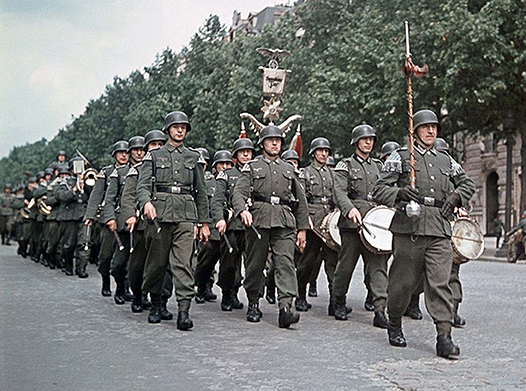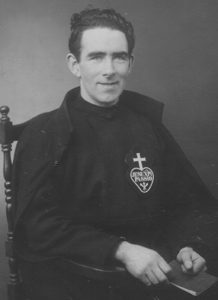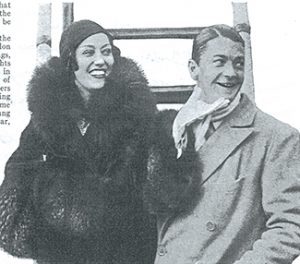Between detention and destitution—the Irish in France during the Occupation
Published in 20th-century / Contemporary History, Features, Issue 5 (September/October 2016), Volume 24HOW DID THE IRISH IN FRANCE FARE DURING THE SECOND WORLD WAR, A PERIOD MARKED BY THE THREAT OF INTERNMENT AND SEVERE FINANCIAL PRESSURES? WHAT WAS THEIR ATTITUDE TOWARD THE GERMAN OCCUPIERS?
By Isadore Ryan
In March 1941 the Irish legation to the État français, set up in Vichy following France’s defeat by the Germans in June 1940, sent a cable to the Department of External Affairs in Dublin stating that ‘the number of Irish citizens and those of Irish birth now requesting passports who are or soon will be destitute is about 300 (not including religious)’. Even if one includes the religious, those not in danger of falling into destitution and those who did not request an Irish passport (James Joyce being the most famous example), it seems reasonable to suggest that the number of Irish or quasi-Irish people in France at this time was under 1,000. Along with priests and nuns, the largest percentage of this number probably consisted of governesses to well-to-do French families.

Above: German troops march through Paris, 1940. In the early weeks of the Occupation, a number of Irish people, mostly with British passports but sometimes even with Irish ones, were picked up by the Germans and thrown into internment camps.
Most Irish in France apolitical
Like the native French population, the vast majority of the Irish stuck in France during the Occupation were largely apolitical, intent on survival in increasingly difficult circumstances (or looking for ways to get out of France via Lisbon), while a few became involved in resistance activities and an even smaller number compromised themselves with the German occupiers. But whatever their politics, one factor unifying the Irish in France during the war was the lack of money, especially as work dried up. For example, Dubliner Charles Edward Joy worked for Chase National Bank in Paris. Joy followed most of the bank’s staff to the small town of Châteauneuf-sur-Cher following the German invasion of 1940, and was still there the following year when he was dismissed by the American bank. Joy made his way back to Paris, where he tried to earn a living as an English teacher in the École de Navigation. But that didn’t last, as all jobs in public institutions were reserved for French nationals, forcing Joy to turn to private lessons. Student numbers dwindled, however, obliging Joy to turn for help to the French social services (which in turn wrote to the Irish legation in Vichy seeking financial aid for him).
Limerick woman Frances Moran ran a finishing school for girls in Petit-Clamart outside Paris. She fled Paris towards the south on 11 May 1940, a day after the Germans launched their Blitzkrieg against France. Moran only managed to get back to Paris a year later—by which time the Germans had converted her school into a Soldatenheim, leaving the Irishwoman little choice but to enquire about leaving France. Likewise, Daniel McAllister, a mechanic from County Down who ran a garage in the Paris suburb of Neuilly, fled south as the Germans approached, and thereafter found it extremely difficult to cross the Demarcation Line established between German-occupied northern France and a southern rump, called the zone libre, that remained unoccupied until November 1942. McAllister wrote to the Irish legation in the hope that it could help him get back to Neuilly, ‘as this inactivity is terrible for me, not forgetting the expense with all going out and nothing coming in’.
In the early weeks of the Occupation a number of Irish people, mostly with British passports but sometimes even with Irish ones, were picked up by the Germans and thrown into internment camps, including one at the Grande Caserne military barracks in Saint Denis, just outside Paris. Most of these people—including five crewmen from the Luimneach, an Irish steamer sunk by a U-boat in September 1940—were quickly released, often after the Irish legation had delivered temporary, one-year, Irish passports to them. Another internment crisis arose in December 1940, when the Germans rounded up a large number of British passport-holders and sent them to an inhospitable seventeenth-century fort in Besançon in eastern France. Those picked up included Margaret Kelly, founder of the Bluebell Girls dance troupe. Being heavily pregnant, she was soon released. Most other Irish detainees—of which a large proportion consisted of nuns—were also freed in early 1941, but some were transferred to the spa town of Vittel after Allied complaints about conditions in Besançon. One Elisabeth Mary McConville was detained in Vittel until March 1943, and an especially unfortunate Donegal woman called Margaret Gallagher was held there until the spring of 1944.
Receive relief and be interned, or go free and starve

Above: Irish Passionist Fr Kenneth Monaghan of St Joseph’s Church, Avenue Hoche—helped downed Allied airmen to make their way to Spain.
In the early part of the war, however, an Irish passport could prove a poisoned gift, for as long as people held a British passport they could depend on financial aid that the London government channelled through the US embassy and American aid organisations (the US did not join the war against Germany until December 1941 and maintained diplomatic relations with the Vichy government for a year more). So, as Irish diplomat Count Gerald O’Kelly de Gallagh put it, ‘the choice before many of them [Irish nationals] is to stick to their British passports, receive relief, and be interned, or else obtain the Irish passports to which they are perfectly entitled, go free and starve’.
The financial pressure that the Irish community in France came under was one of the main preoccupations of the Irish legation in 1940–5. Nevertheless, the response of the Irish authorities was cautious—not to say lethargic. The situation came to the notice of one Susan Hilton, a shipwrecked English alcoholic who turned up in Paris at the end of 1940. In a July 1941 letter to William Warnock at the Irish legation in Berlin, Hilton wrote:
‘The British are getting support through the American authorities, while the Irish, who have nothing to do with the war, are left destitute … The British are now jeering and saying: “See now what your freedom means”. And certainly they have their justification. I myself feel that this state of affairs has arisen because Dublin is not fully aware of the appalling distress amongst the nationals in occupied territory.’

Above: Corkman Michael Farmer (right), briefly married to American film actress Gloria Swanson (left) in the early 1930s, was arrested for collaboration in November 1944 but convinced the French authorities that it consisted in little more than debauched drinking sessions with the local Gestapo; the case against him was dropped in September 1945. (Photoplay, February 1932)
With the Dublin authorities anxious about the welfare cost involved, Seán Murphy, Ireland’s minister to France, was forced to reduce drastically the numbers of people who might be eligible for financial assistance from his March 1941 estimate of about 300. By July 1941 the legation had only identified a handful of full Irish citizens ‘in financial need’, and a further list drawn up in January 1942 was only slightly longer. In the summer of 1941 the Irish gradually established a system that allowed relatives back in Ireland to send people in France a monthly allowance via the Irish legation. But tight capital controls meant that the amount was limited to a maximum of £15 per single person, £25 per married couple and £5 per child. These ceilings remained virtually unchanged until spring 1944, in spite of high inflation. At the exchange rate applied, £15 worked out at FF2,640, which, according to the French national statistics agency, INSEE, was worth the present-day equivalent of €897 in 1941, €745 in 1942 and only €491 in 1944. Samuel Beckett wrote to the legation from the south of France in late 1942 to ask that the amount of money he received from Ireland be increased, ending his letter with a sideswipe at the Department of External Affairs: ‘It is certain,’ he wrote, ‘that the Department expects us to live on our patrimoine.’
No doubt penniless and friendless after their release from Vittel, both Margaret Gallagher and Elisabeth McConville made their way to the Irish Convent on the Rue Murillo in the eighth arrondissement in Paris. By doing so, they were following in the footsteps of many other Irish women in Paris during the war. The convent in Rue Murillo, run by the predominantly Irish order of the Poor Servants of the Mother of God, had provided board and lodgings for young women from Britain and Ireland before the Occupation, but the nuns and their 22 lodgers were rounded up in December 1940 and sent to Besançon. After their release, the Poor Servants continued to provide shelter for young Irish women; in June 1945, 24 women were still residing in the Rue Murillo. The other main focus point of the Irish community in Paris was St Joseph’s Church on the Avenue Hoche, not far from Rue Murillo. The church was run by Irish Passionists, including their superior, Fr Cornelius O’Grady from County Roscommon, Fr Alphonsus O’Farrell from County Galway, and Fr Kenneth Monaghan from County Sligo. Both Fr O’Grady and Fr Monaghan were briefly detained on separate occasions in 1940 but, once released, the priests helped downed Allied airmen (including one Bill McGrath from Clones, Co. Monaghan) to make their way to Spain. In 1946 the US War Department wanted to show its appreciation for the help the Irish Passionists gave to downed airmen, but found that Fr O’Grady in particular was ‘staunch in his refusal of any recognition for his work’.
Resistance
Irish people who took an active role in resisting the Germans in one form or another are relatively well documented. Their number included, most famously, Samuel Beckett, who narrowly avoided arrest in September 1942. Robert Armstrong, a First World War veteran from Edgeworthstown, Co. Longford, worked for the Imperial War Graves Commission in Valenciennes in northern France. He became involved in resistance activities before being arrested and deported to Germany in November 1943. Armstrong died in the Waldheim camp for political prisoners in December 1944. Dublin-born Robert Vernon, son of Edward Kingston Vernon of Clontarf Castle and a radio operator for the Alliance resistance movement in southern France, was killed in an SS massacre of prisoners at the Sonnenberg concentration camp in January 1945. But perhaps the most implacable Irish résistante was Janie McCarthy from Killarney, Co. Kerry. This schoolteacher became involved in intelligence-gathering right from the beginning of the Occupation and was heavily involved in ferrying downed Allied pilots out of Paris and to safety. Miraculously, while many of her associates were sent to concentration camps, McCarthy avoided arrest for the entire four years she was active. Another McCarthy, Kate, from Drimoleague, Co. Cork, who worked as Sister Marie Laurence in a hospital in Béthune in northern France, also joined the resistance very early in the war and was deemed by French Resistance officials to have organised ‘the sheltering and the passage to England of 200 British officers and soldiers from the Dunkirk pocket’ in May/June 1940. Thereafter, Sister Marie Laurence gathered intelligence for transmission to England until her arrest in June 1941. She spent time in a succession of camps, ending up in Ravensbrück. By the time of her liberation in April 1945, the Irishwoman weighed only 27 kilos.
Collaboration
Other Irish people went down a different path. The aforementioned Susan Hilton (granted a one-year Irish passport on the strength of her father’s birth in Donegal) worked for German propaganda and was subsequently found guilty of treason by the British in 1946. One Denis Corr, born in Dundalk in 1876 and resident in Biarritz, was hauled before the French courts in December 1945 on a charge of espionage for the Germans. He was found guilty of the lesser charge of damaging national defence, sentenced to six months’ imprisonment, fined FF3,000 and ordered to pay court expenses. Corkman Michael Farmer, briefly married to American film actress Gloria Swanson in the early 1930s, was arrested in Paris on 8 November 1944 and immediately sent to the town of Brive, where he was accused of ‘intelligence with the enemy’. In the end, Farmer convinced the authorities that his ‘intelligence with the enemy’ consisted in little more than debauched drinking sessions with the local Gestapo and the case against him was dropped in September 1945.
Isadore Ryan is the author of Irish Paris—stories of famous and infamous Irish people in Paris through the centuries (2013).
Read More:
Count Gerald O’Kelly de Gallagh
FURTHER READING
C. Crowe, R. Fanning, M. Kennedy, D. Keogh & E. O’Halpin (eds), Documents on Irish Foreign Policy, vol. VI (1939–1941) and vol. VII (1941–1945) (Dublin, 2008, 2010).
C. Desprairies, Paris dans la Collaboration (Paris, 2009).
N. Keogh, Con Cremin, Ireland’s wartime diplomat (Cork, 2006).
P. Travers, ‘Some experiences during the war years: the Irish College in Paris 1939–1945’, Colloque 18 (Autumn 1988).
















